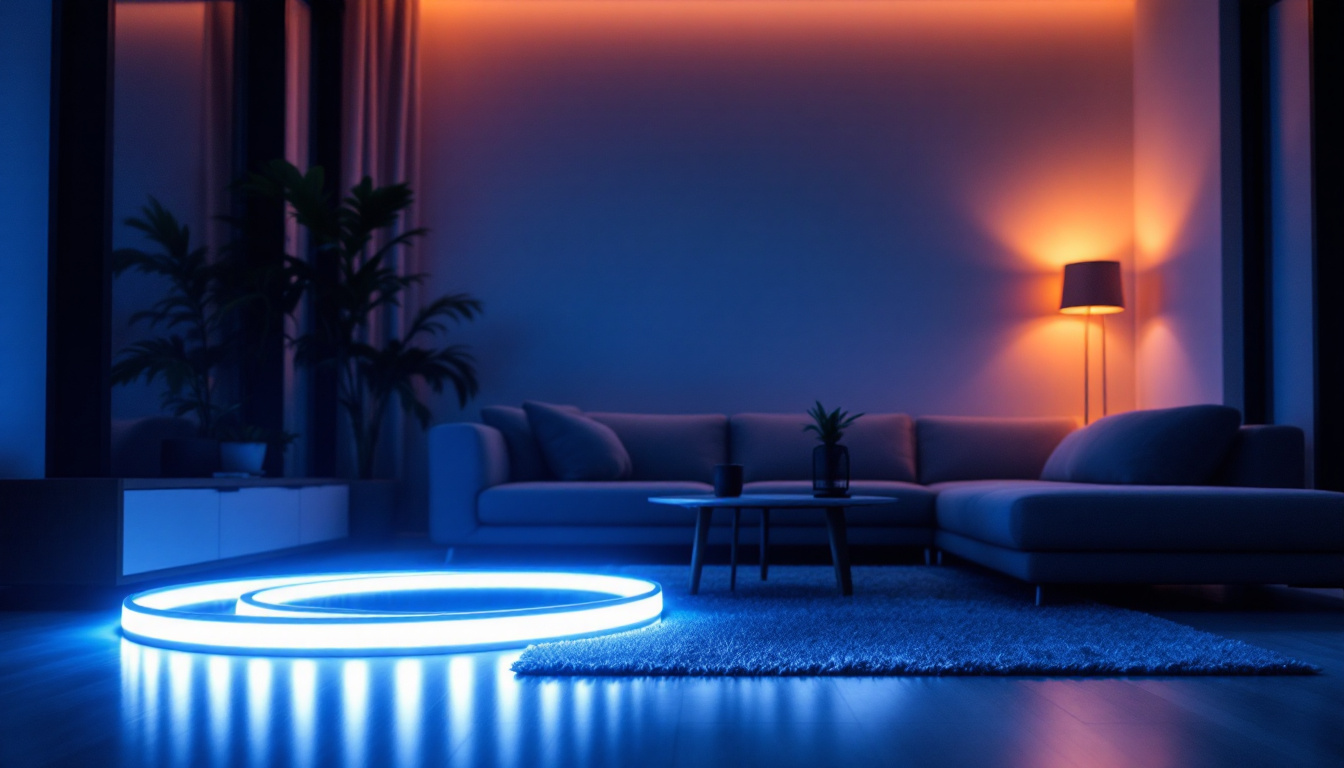

In the realm of modern lighting solutions, LED light strips have emerged as a versatile and energy-efficient option that caters to a variety of applications. From residential spaces to commercial environments, these strips offer a blend of functionality and aesthetic appeal, making them a popular choice among lighting contractors. This article delves into the role of LED light strips in contemporary lighting design, exploring their benefits, applications, and the future of this innovative technology.
LED light strips, also known as LED tape lights, are flexible circuit boards populated with light-emitting diodes (LEDs). They come in various lengths and can be cut to fit specific spaces, making them incredibly adaptable. The strips are typically backed with adhesive, allowing for easy installation on a variety of surfaces.
One of the defining features of LED light strips is their ability to emit light in a range of colors and intensities. This versatility allows for creative lighting solutions that can enhance the ambiance of any environment. Additionally, the low heat output of LEDs ensures safety and longevity, further solidifying their status as a preferred lighting option.
LED light strips boast several key features that set them apart from traditional lighting options. Firstly, they are energy-efficient, consuming significantly less power while providing the same or greater illumination. This efficiency not only reduces energy costs but also minimizes environmental impact.
Secondly, the flexibility of LED strips allows for unique installation possibilities. They can be used in tight spaces, around corners, or even integrated into furniture designs, providing lighting solutions that are both functional and aesthetically pleasing.
There are various types of LED light strips available, each designed for specific applications. For instance, RGB (Red, Green, Blue) strips allow users to customize colors, making them ideal for mood lighting or decorative purposes. On the other hand, white LED strips can range from warm to cool tones, catering to different lighting needs.
Additionally, waterproof LED strips are available for outdoor use or in areas prone to moisture, such as kitchens and bathrooms. Understanding the different types of LED light strips is crucial for contractors aiming to provide tailored lighting solutions to their clients.
The versatility of LED light strips makes them suitable for a wide array of applications. From accent lighting in homes to functional lighting in commercial spaces, their adaptability is unmatched.
In residential settings, LED light strips can be used to create ambient lighting in living rooms, bedrooms, and kitchens. They can be installed under cabinets to illuminate countertops or along staircases for safety. Moreover, their ability to change colors can enhance the mood for various occasions, making them a favorite among homeowners.
Furthermore, LED strips can be integrated into architectural features, such as cove lighting or behind mirrors, adding depth and dimension to a space. This creative use of lighting can transform a standard room into a visually stunning environment.
In commercial and retail environments, LED light strips serve both functional and aesthetic purposes. They can be used to highlight products on display, draw attention to signage, or create an inviting atmosphere for customers. The energy efficiency of LED strips also aligns with the sustainability goals of many businesses, making them an attractive option for modern commercial lighting.
Additionally, programmable LED strips can be synchronized with music or events, enhancing the customer experience in venues such as restaurants, bars, and entertainment spaces. This dynamic capability allows businesses to adapt their lighting to suit different moods and occasions.
Architects and landscape designers are increasingly incorporating LED light strips into their projects. These strips can be used to accentuate architectural details, illuminate pathways, or highlight landscaping features. The flexibility of LED strips allows for creative solutions that enhance the overall design of a space.
Moreover, outdoor LED strips can withstand various weather conditions, making them suitable for year-round use. This durability, combined with their aesthetic appeal, positions LED light strips as a go-to choice for outdoor lighting solutions.
The adoption of LED light strips offers numerous benefits, both for contractors and their clients. Understanding these advantages can help lighting professionals make informed decisions when selecting lighting solutions.
One of the most significant benefits of LED light strips is their energy efficiency. Compared to traditional incandescent or fluorescent lighting, LEDs consume a fraction of the power while providing superior brightness. This efficiency translates to lower energy bills and a reduced carbon footprint, making them an environmentally friendly choice.
Furthermore, the longevity of LED light strips means they require less frequent replacement, reducing maintenance costs and waste. For contractors, this translates to satisfied clients who appreciate the long-term savings associated with LED lighting.
LED light strips are incredibly versatile, allowing for a wide range of applications and designs. They can be cut to size, bent, and shaped to fit various spaces, making them ideal for both residential and commercial projects. This adaptability enables contractors to create customized lighting solutions that meet the unique needs of their clients.
Additionally, the ability to change colors and intensities adds another layer of customization. Clients can adjust their lighting to suit different moods or occasions, enhancing the overall experience of their spaces.
LED light strips emit very little heat compared to traditional lighting options, making them a safer choice for various applications. This low heat output reduces the risk of burns or fire hazards, particularly in enclosed spaces or areas with flammable materials.
Moreover, the safety aspect of LED strips is particularly appealing for contractors working in residential settings, where families and children are present. Providing clients with safe lighting solutions can significantly enhance their trust and satisfaction.
While LED light strips offer numerous advantages, proper installation is crucial to ensure optimal performance and longevity. Contractors should consider several factors when installing these lighting solutions.
Before installing LED light strips, it is essential to prepare the surface adequately. The adhesive backing of the strips requires a clean, smooth surface for optimal adhesion. Dust, grease, or uneven surfaces can hinder the installation process and affect the longevity of the strips.
In cases where the surface is not suitable for adhesive application, alternative mounting options, such as clips or channels, can be utilized. Ensuring proper surface preparation is a key step in achieving a successful installation.
LED light strips require a compatible power supply to function correctly. Contractors should ensure that the power supply matches the voltage and wattage requirements of the strips being used. Additionally, proper wiring and connectivity are essential to prevent flickering or failure of the lights.
Using connectors and extension cables designed for LED strips can simplify the installation process and enhance reliability. It is advisable to consult the manufacturer’s specifications to ensure compatibility and safety.
Although LED light strips emit low heat, proper heat management is still important to maintain performance and longevity. Installing the strips in well-ventilated areas can help dissipate any heat generated during operation.
For longer runs of LED strips, it may be beneficial to use aluminum channels or heat sinks to further manage heat and protect the LEDs. Contractors should be aware of these considerations to ensure the best performance from their installations.
The future of LED light strips looks promising, with ongoing advancements in technology and design. As the demand for energy-efficient and customizable lighting solutions continues to grow, manufacturers are constantly innovating to meet these needs.
One of the most significant trends in the lighting industry is the integration of smart technology. LED light strips are increasingly being designed to work with smart home systems, allowing users to control their lighting through mobile apps or voice commands.
This integration not only enhances convenience but also allows for greater customization of lighting settings. Users can program their LED strips to change colors, adjust brightness, or even sync with music, creating dynamic lighting experiences that were previously unattainable.
Future developments in LED technology are likely to focus on improving color rendering and efficiency. As manufacturers continue to refine LED technology, the quality of light produced by LED strips will become even more natural and vibrant.
Moreover, advancements in energy efficiency will further reduce power consumption, making LED light strips an even more attractive option for contractors and clients alike. Staying informed about these developments will be crucial for lighting professionals looking to provide cutting-edge solutions.
As sustainability becomes a more pressing concern, the lighting industry is shifting towards eco-friendly practices. Future LED light strips may incorporate recyclable materials and sustainable manufacturing processes, aligning with the growing demand for environmentally responsible products.
Contractors who prioritize sustainability in their projects will find that offering eco-friendly LED solutions can attract environmentally conscious clients and set them apart in a competitive market.
LED light strips play a pivotal role in modern lighting solutions, offering versatility, energy efficiency, and aesthetic appeal. Their applications span across residential, commercial, and outdoor settings, making them a valuable asset for lighting contractors. Understanding the benefits, installation considerations, and future trends associated with LED light strips can empower contractors to provide innovative and effective lighting solutions for their clients.
As the lighting industry continues to evolve, embracing the potential of LED light strips will be essential for contractors looking to stay ahead of the curve. By leveraging the advantages of this technology, lighting professionals can enhance their offerings and contribute to the creation of beautiful, functional, and sustainable spaces.
Ready to elevate your lighting solutions with the versatility and efficiency of LED light strips? At LumenWholesale, we provide lighting contractors with the highest quality, spec-grade LED products at unbeatable wholesale prices. Say goodbye to local distributor markups and hello to our extensive selection that meets rigorous industry standards. With free shipping on bulk orders, you can trust that you’re getting premium lighting at the best value — no hidden fees, no compromises. Enhance your lighting projects today and experience the LumenWholesale difference. Visit us at Wholesale Lighting at the Best Value and let us light up your world with affordability and excellence.

Discover the essential insights every lighting contractor needs to know about fluorescent lights, from energy efficiency and installation tips to troubleshooting common issues.

Discover expert insights on selecting the best LED bulbs for home installations, tailored specifically for lighting contractors.

Discover why the T5 fluorescent tube is the unsung hero in lighting projects.

Discover how choosing the right power cords can significantly cut expenses for lighting contractors.
Get notified when NEW deals are released.
Optimize your budget with wholesale discounts.
Only top-quality, specification-grade lighting products.
No additional costs at checkout - what you see is what you pay.
We understand the unique needs of contractors.